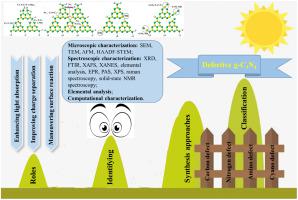Advances in Colloid and Interface Science ( IF 15.6 ) Pub Date : 2021-09-09 , DOI: 10.1016/j.cis.2021.102523 Longbo Jiang 1 , Jinjuan Yang 2 , Xingzhong Yuan 2 , Jiayin Guo 2 , Jie Liang 2 , Wangwang Tang 2 , Yaoning Chen 2 , Xiaodong Li 2 , Hou Wang 2 , Wei Chu 3

|
Polymer carbon nitride (CN) has unique structure and electronic properties, making it attractive in photocatalysis fields. However, the photocatalytic efficiency of the pristine CN photocatalyst is still unsatisfactory. In this regard, the introduction of vacancy defects can effectively tune photoelectric properties of CN photocatalyst through tailoring the electronic structure and bandgap engineering. In this review, the effect of vacancy defects on CN is reviewed from the aspects of light absorption, charge separation and surface photoreactivity of CN. Meanwhile, the current progress in the design of vacancy defects with the classified carbon vacancies (CVs), nitrogen vacancies (NVs), amino and cyano groups on CN to boost the photocatalytic performance is summarized. Furthermore, various characterization methods have been summarized and highlighted, including microscopic characterization (SEM, TEM, AFM, HAADF-STEM), spectroscopic characterization (XRD, FTIR, XAFS, XANES, EPR, PAS, XPS, raman spectroscopy, solid-state NMR spectroscopy), elemental analysis, and computational characterization. Finally, the future opportunities and challenges of CN photocatalysts designed with vacancies and defects are proposed to highlight the development direction of this research field.
中文翻译:

聚合氮化碳光催化剂的缺陷工程:合成、性质和表征
聚合物氮化碳 (CN) 具有独特的结构和电子特性,使其在光催化领域具有吸引力。然而,原始的 CN 光催化剂的光催化效率仍然不尽如人意。在这方面,空位缺陷的引入可以通过调整电子结构和带隙工程来有效地调节 CN 光催化剂的光电性能。本综述从CN的光吸收、电荷分离和表面光反应性等方面综述了空位缺陷对CN的影响。同时,总结了在 CN 上分类碳空位 (CVs)、氮空位 (NVs)、氨基和氰基以提高光催化性能的空位缺陷设计的当前进展。此外,总结并强调了各种表征方法,包括显微表征(SEM、TEM、AFM、HAADF-STEM)、光谱表征(XRD、FTIR、XAFS、XANES、EPR、PAS、XPS、拉曼光谱、固态核磁共振光谱) 、元素分析和计算表征。最后,提出了空位和缺陷设计的CN光催化剂的未来机遇和挑战,以突出该研究领域的发展方向。


























 京公网安备 11010802027423号
京公网安备 11010802027423号